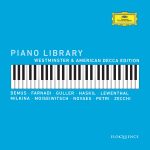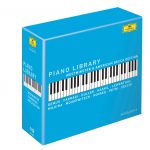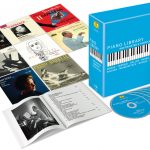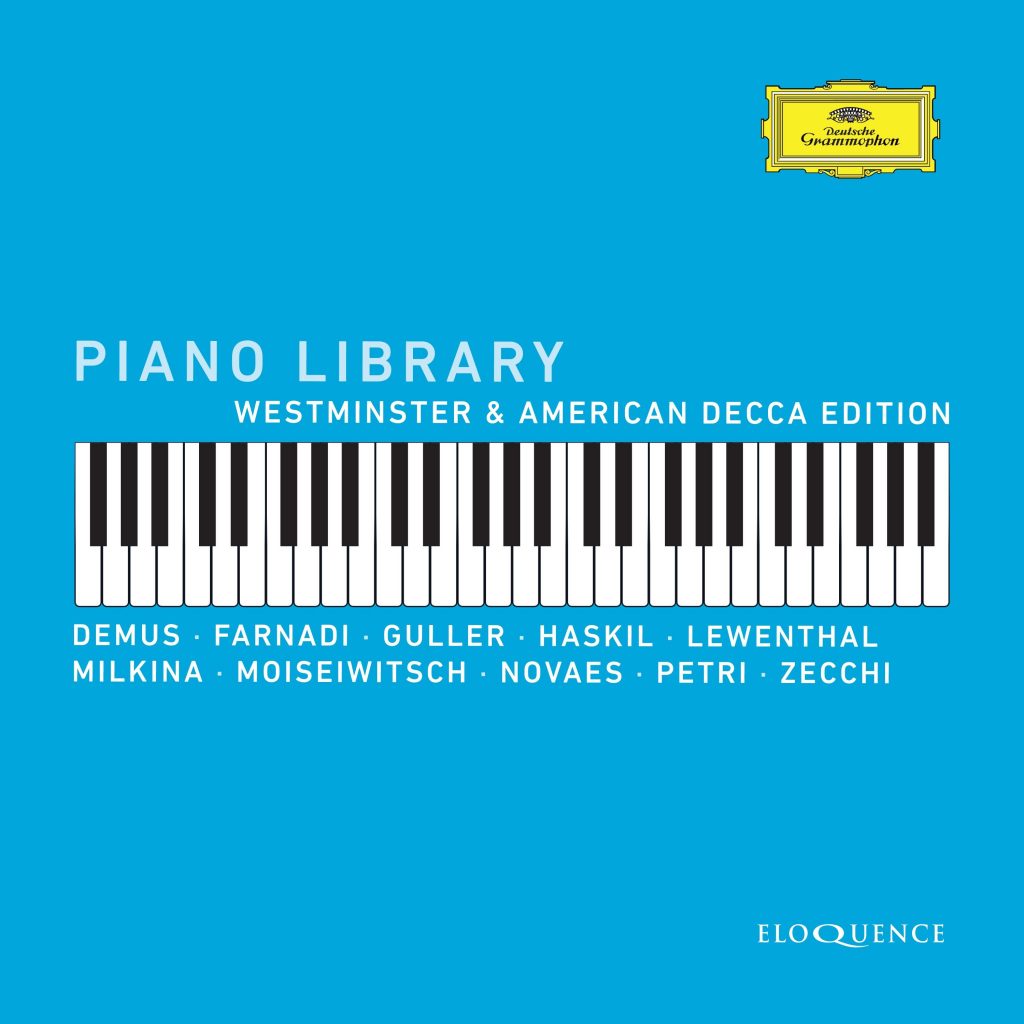
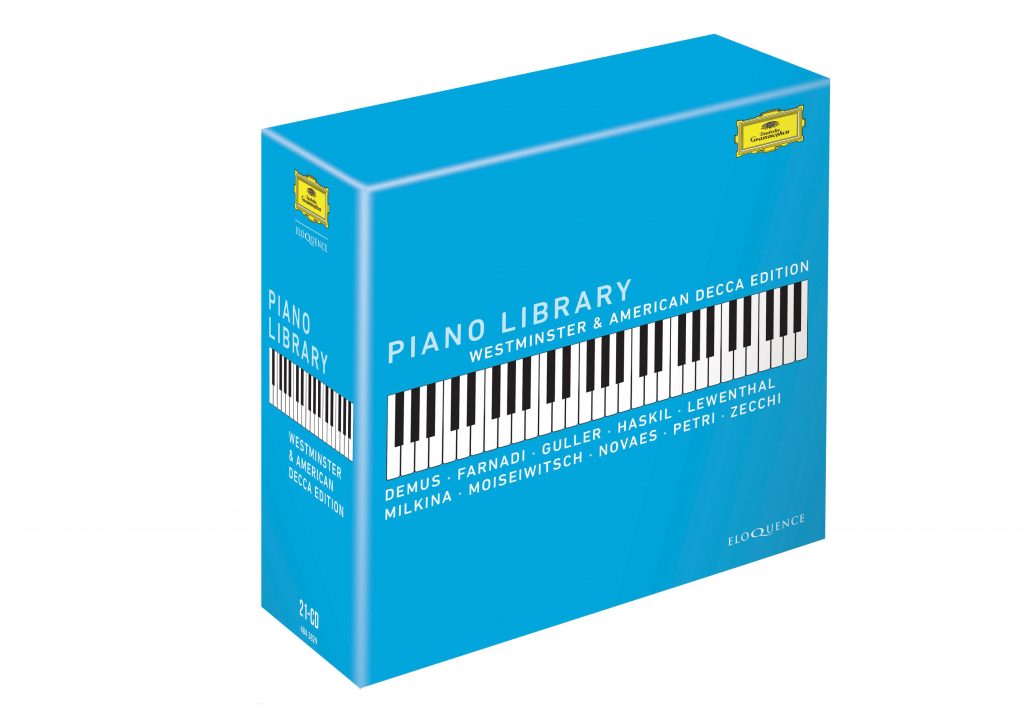
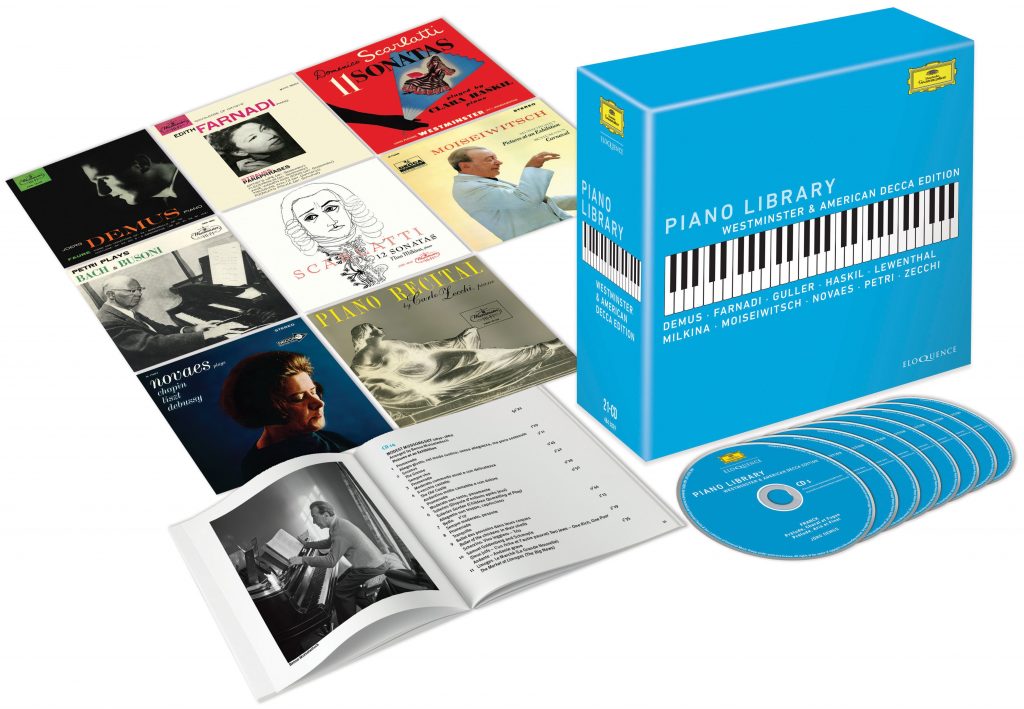
Spanning 1950 to 1963 – Clara Haskil in Scarlatti to Guiomar Novaes in Chopin and Debussy – the recordings in this set document the end of some distinguished careers (notably Benno Moiseiwitsch and Egon Petri) and the early flourishing of others, such as Jörg Demus and Nina Milkina. Classic examples of German, Russian, French, Hungarian, Romanian and American pianism illustrate the characteristics of their national schools, but most of all underline the personal artistry of musicians such as Haskil and Moiseiwitsch who always turned a phrase or a chord and made it their own.
The four solo LPs for Westminster recorded in 1956 by Raymond Lewenthal marked his return to the studio after an assault which had left him unable to play for several years. He would go on to become an early champion on record of the late-Romantic, ultra-virtuoso style, but these Westminster LPs capture him in repertoire from Beethoven sonatas and Scriabin preludes to popular encores.
Excerpts from some of these LPs have appeared on CD before, but not the full albums as originally sequenced. This is also true of the treasurable August 1961 sessions in New York made by Benno Moiseiwitsch, playing inimitably inflected accounts of Beethoven, Schumann and Mussorgsky. There is a first-time CD release for Petri’s ‘Moonlight’ Sonata, alongside its original LP couplings of the ‘Pathétique’ and ‘Appassionata’, plus the ‘Hammerklavier’ and Busoni’s Fantasia contrappuntistica from the same sessions in June 1956.
Petri’s aristocratic and intellectual style could hardly be more contrasted with the spontaneous rubato of the Brazilian pianist Guiomar Novaes, in Chopin’s Barcarolle. A trio of previously unissued Chopin Mazurkas makes a precious addition to the legacy of the French pianist Youra Guller. Jörg Demus is now esteemed for his Bach and Beethoven, but his mastery of Franck and Fauré has been forgotten. Each of these LPs tells its own story, of a forgotten pianist or a little-known recording, and the piano-specialist Mark Ainley supplies valuable context with new booklet appreciations of each artist.
CD 1
FRANCK Prélude, Choral et Fugue
Prélude, Aria et Final
JÖRG DEMUS
CD 2
FAURÉ Impromptus Op. 25*, 31, 34*, 91 & 102
Thème et Variations
Barcarolle, Op. 70
Nocturne, Op. 63 No. 6
JÖRG DEMUS
*FIRST RELEASE ON CD
CD 3
LISZT Soirées de Vienne
EDITH FARNADI
FIRST RELEASE ON CD
CD 4
Johann Strauss Waltz Paraphrases
GODOWSKY Symphonic Metamorphosis on Künstlerleben
Symphonic Metamorphosis on Die Fledermaus
Symphonic Metamorphosis on Wein, Weib und Gesang
DOHNÁNYI Schatz-Walzer (Der Zigeunerbaron)
SCHULHOF Pizzicato Polka
EDITH FARNADI
FIRST RELEASE ON CD
CD 5
SCARLATTI Keyboard Sonatas
Kk. 247, 2, 132, 35, 193, 386, 519, 322, 87, 515, 437
CLARA HASKIL
CHOPIN Mazurkas
F minor, Op. 7 No. 3; D flat major, Op. 30 No. 3; C major, Op. 56 No. 2
YOURA GULLER
PREVIOUSLY UNPUBLISHED – FIRST RELEASE
CD 6
BEETHOVEN
Piano Sonata Nos. 8, 14 & 23
RAYMOND LEWENTHAL
FIRST RELEASE ON CD
CD 7
SCRIABIN Fantasy; Vers la flamme
5 Préludes, Op. 74
24 Préludes, Op. 11
RAYMOND LEWENTHAL
CD 8
Moonlight and Keyboard
DEBUSSY Clair de lune (from Suite bergamasque)
LISZT Liebestraum No. 3 in A flat major
SAINT-SAËNS–GODOWSKY Le Cygne (from Carnaval des animaux)
RACHMANINOFF–LEWENTHAL Zdes’ khorošo
BRAHMS Waltz in A flat major, Op. 39 No. 15*
CHOPIN Nocturne in F sharp major, Op. 15 No. 2*
CHOPIN Nocturne in E flat major, Op. 9 No. 2*
TRADITIONAL/LEWENTHAL Greensleeves
CHOPIN Waltz in C sharp minor, Op. 64 No. 2*
MASSENET Élégie (from Les Érinnyes)
RUBINSTEIN Romance in E flat major, Op. 44 No. 1
SCHUMANN Träumerei (from Kinderszenen, Op. 15)*
BEETHOVEN Adagio sostenuto (from Piano Sonata, Op. 27 No. 2 ‘Moonlight’)*
SCHUBERT–LISZT Ständchen (from Schwanengesang, D. 957)
MENDELSSOHN–LISZT Auf Flügeln des Gesanges
CHOPIN Impromptu No. 4 in C sharp minor, Op. 66 ‘Fantaisie-Impromptu’*
RAYMOND LEWENTHAL
*FIRST RELEASE ON CD
CD 9
Toccatas for Piano
DELLA CIAIA Toccata in G minor
J.S. BACH Toccata in C minor BWV 911
CZERNY Toccata in C major, Op. 92
ALKAN Toccatina in C minor, Op. 75
SCHUMANN Toccata in C major, Op. 7
PROKOFIEV Toccata, Op. 11
DEBUSSY Toccata (from Pour le Piano)
RAVEL Toccata (from Le Tombeau de Couperin)
JELOBINSKY Toccata in C major, Op. 19, No. 1
LEWENTHAL Toccata alla Scarlatti
MENOTTI Ricercare and Toccata on a theme from ‘The Old Maid and the Thief’
RAYMOND LEWENTHAL
CD 10
SCARLATTI Keyboard Sonatas
Kk. 190, 208, 396, 481, 447, 507, 450, 161, 29, 107, 125, 527
NINA MILKINA
FIRST RELEASE ON CD
CD 11
C.P.E. BACH Keyboard Sonatas
F minor, H.173; A minor, H.247; A major, H.186; D major, H.286
NINA MILKINA
FIRST RELEASE ON CD
CD 12
BEETHOVEN Piano Sonatas Nos. 14 & 26; Andante favori
SCHUMANN Vogel als Prophet
BENNO MOISEIWITSCH
CD 13
SCHUMANN Kreisleriana; Kinderszenen
Romance, Op. 28 No. 2; Arabeske
BENNO MOISEIWITSCH
CD 14
MUSSORGSKY Pictures at an Exhibition
SCHUMANN Carnaval
BENNO MOISEIWITSCH
CD 15
CHOPIN Barcarolle, Op. 60
DEBUSSY Les collines d’Anacapri (Préludes, Livre I No. 5)
La soirée dans Grenade (from Estampes)
Poissons d’or (from Images, Livre II)
Minstrels (Préludes, Livre I No. 12)
LISZT Études de Concert, S.145
Liebestraum No. 3
Valse oubliée No. 1
Hungarian Rhapsody No. 10
GUIOMAR NOVAES
FIRST RELEASE ON CD
CD 16
BEETHOVEN Piano Sonatas Nos. 8, 14* & 23
EGON PETRI
*FIRST RELEASE ON CD
CD 17
BEETHOVEN Piano Sonatas No. 29
EGON PETRI
CD 18
BUSONI Fantasia contrappuntistica
BACH–BUSONI Chorale Preludes:
Wachet auf, ruft uns die Stimme
In dir ist Freude
Ich ruf zu dir, Herr Jesu Christ
Nun freut euch, liebe Christen g’mein
BUXTEHUDE–PETRI Wir danken dir, Herr Jesu Christ
BACH–PETRI
Vor deinen Thron tret’ ich hiermit
Minuet from Klavierbüchlein für Wilhelm Friedmann Bach
Schafe können sicher weiden (Sheep may safely graze)
EGON PETRI
CD 19
BACH–BUSONI
Toccata and Fugue in D minor, BWV 565
Toccata, Adagio and Fugue in C major, BWV 564
Prelude and Fugue in E flat major, BWV 552
Prelude and Fugue in D major, BWV 532
EGON PETRI
CD 20
Liszt – The Famous Piano Transcriptions from Mozart to Mendelssohn
MENDELSSOHN–LISZT Wedding March and Elfin Chorus from ‘A Midsummer Night’s Dream’
GOUNOD–LISZT Valse de l’opéra Faust de Gounod, S. 407 – Paraphrase de concert
BEETHOVEN–LISZT Adelaïde
LISZT–BUSONI Mephisto Waltz No. 1; Fantasia on two themes from Mozart’s The Marriage of Figaro, S. 697
EGON PETRI
CD 21
SCARLATTI Sonatas, Kk. 159 & 259
J.S. BACH Prelude and Fugue No. 13 in F sharp major, BWV 858 (Well-Tempered Clavier Book I)
Two-Part Invention No. 11 in G minor, BWV 782
MOZART Piano Sonata No. 9 in D major, K. 311
CHOPIN Mazurkas Op. 41 No. 1 & Op. 17 No. 4
SCHUMANN Kinderszenen
CARLO ZECCHI
“Mr. Demus’s performances seem above reproach.” High Fidelity, July 1953 (Demus – Franck)
“If César Franck ever played the Prelude, Chorale and Fugue with the power and passion that Jörg Demus puts into it, his tiresome wife’s suspicions would have been amply confirmed … [Demus] has the power of seeing a work as a whole which, in both these pieces, is of supreme importance.” Gramophone, January 1954 (Demus – Franck)
“Demus not only does full justice to this French music, he does it honor. His approach is warm, sensitive, often forceful yet never forced, and Westminster has allowed the tone of his piano to sound glitteringly natural.” High Fidelity, 1956 (Demus – Fauré)
“Miss Farnadi has a real flair for these works, as she does for Liszt’s (with which they have much in common). She does not lose sight of the basic tunes and dance rhythms, but she handles the decorative material with great delicacy, color, and appropriate capriciousness.” High Fidelity, May 1956 (Farnadi – Strauss paraphrases)
“Haskil is in top form here, playing with warmth and finesse, understanding for the outline, and wonderful attention to detail … Her ornamentation is skilful but not fussy, her tone, at all times, beautifully controlled.” High Fidelity, September 1951 (Haskil – Scarlatti)
“If somewhat rough-hewn, the playing has a firm, direct quality in stereo.” High Fidelity, September 1958 (Lewenthal – Beethoven)
“Lewenthal is just the man for this sort of thing and his large-scale, generous approach generates plenty of excitement. The early Preludes are gracefully and poetically played.” High Fidelity, April 1970 (Lewenthal – Scriabin)
“Raymond Lewenthal is revered by pianophiles, even if only the most avid of them will have the original long out-of-print Westminster LPs … The playing is sensational.” Gramophone, September 2012 (Lewenthal)
“Mr. Lewenthal, a young pianist from Texas, has the technique for these works, which is saying a great deal, and he does not overlook musical values either.” High Fidelity, May 1957 (Lewenthal – Toccatas)
“Nina Milkina’s Scarlatti combines a matchless alternating verve and reflection with character and resource.” Gramophone (Milkina – Scarlatti)
“At all times there is musical beauty, wit, and charm for those who will listen closely and repeatedly. Fortunately, the performances are stylistically pure, for Miss Milkina plays with crisp, clean articulation, an exactly controlled dynamic scale, and serenity of spirit.” High Fidelity, August 1959 (Milkina – C.P.E. Bach)
“Played from the heart with an unfailingly lovely tone.” Gramophone, September 2012 (Moiseiwitsch – Beethoven)
“If you look upon these works as romantic pieces, best realized in a ripely expressive manner with a tasteful application of sentiment. Moiseiwitsch offers the best of the stereo editions, even surpassing the recent Rubinstein set.” High Fidelity, September 1963 (Moiseiwitsch – Beethoven)
“This is the sort of Schumann interpretation that charmed Victorian and Edwardian audiences … Kreisleriana has many diverse moods and benefits from Moiseiwitsch’s whimsical resourcefulness.” High Fidelity, July 1962 (Moiseiwitsch – Schumann)
“Moiseiwitsch had an interesting enough musical personality to hold one with him in most things he did … He never played just notes; he played the music as he perceived it; and this is what he offers here. In the context of piano-playing today, the recording comes as a slightly old-fashioned but rather interesting document.” Gramophone, June 1964 (Moiseiwitsch – Beethoven)
“The pianist gives both works old-style performances, ones in which inner voices are stressed and much rubato permitted … One can appreciate many rarefied details in Moiseiwitsch’s guided tour – the unhatched chicks chirp engagingly…” High Fidelity, April 1962 (Moiseiwitsch – Mussorgsky)
“The Liszt works are played with emphasis on poetry and washes of colour rather than with the customary brilliance and dash. She indulges in lavish pedal effects, producing a lovely atmosphere.” High Fidelity, September 1963 (Novaes recital)
“Mme. Novaes’ supreme gift is that of eliciting tonal beauty from the keyboard … to hear the exquisitely spun phrasing of the Chopin slow movement, the magical coloration she imparts to the Debussy pieces … such experiences epitomize the most treasurable aspects of Novaes’ artistry.” Stereo Review, November 1963 (Novaes recital)
“Heartily devout playing that makes much of round-shaping a phrase and warming a chord in a frank exploitation of expression neatly eluding extravagance.” High Fidelity, March 1957 (Petri – Beethoven)
“The Appassionata is perhaps the most remarkable of the three … the sheer urgency and excitement of this playing is a joy. In my experience Beethoven does not appeal to young people today as he did before the war, but I think he would if there were more Petris around.” Gramophone, June 1961 (Petri – Beethoven)
“Petri … strove to realize what might be called the ‘architexture’ of the music… Petri opts for a tight-knit realization in relatively fast tempi.” Stereo Review, August 1968 (Petri – Beethoven Hammerklavier)
“If one wants to hear the [Bach chorale preludes] played on the piano by a very sensitive musician, this record will serve admirably.” High Fidelity, September 1959 (Petri – Bach/Busoni)
“The Fantasia Contrappuntistica was probably Busoni’s masterpiece for the piano, and it receives a quite staggering performance … Petri is superb at juggling with several strands of counterpoint and almost never loses clarity. I found this performance overwhelming, and I have played it again and again.” Gramophone, June 1961 (Petri – Busoni)
“The D minor Toccata and Fugue sounds tremendous and the climax is overwhelming … The E flat prelude gets a knock-out of a performance.” Gramophone, June 1961 (Petri – Bach)
“An extraordinarily interesting document … Petri’s style of playing is descended through Busoni’s through Liszt’s; and it almost goes without saying that his feeling for the spirit in which these transcriptions were made is something that no other living pianist can rival.” Gramophone, April 1962 (Petri – Liszt)
“[Zecchi] is at his best in the Chopin mazurkas, which profit from his beautiful singing tone and lovely cantilena and are properly moody and capricious.” High Fidelity, June 1956 (Zecchi recital)

